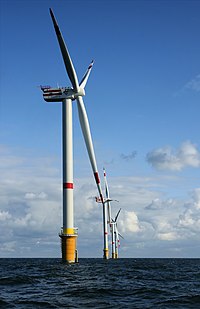
Photo from wikipedia
A scaled, 7.5-mm thick, unidirectional glass/epoxy wind turbine spar cap cured in a vacuum-assisted oven was found to have attained non-uniform thickness along its length. Edge deformations were severe, leading… Click to show full abstract
A scaled, 7.5-mm thick, unidirectional glass/epoxy wind turbine spar cap cured in a vacuum-assisted oven was found to have attained non-uniform thickness along its length. Edge deformations were severe, leading to noticeable edge curvature even at the vacuum pressure. These unforeseen discrepancies could only be predicted and/or dealt beforehand through a process simulation that integrates the complete processing physics. A fully coupled numerical simulation of composites manufacturing was established and implemented for a portion of a spar cap in multiphysics finite element software. Phenomena such as resin flow-induced compaction and cure-induced deformation were captured. The simulation results indicated that even though the distorted edge of the laminate is trimmed off, there will still be some curvature left within the part. It was noted that simulating percolation flow of resin alone leads to less accurate deformation predictions. Therefore, a method to include shear flow-induced deformation of the resin-saturated fiber beds were proposed and implemented. Such a fully coupled and integrated procedure is useful for optimizing process parameters to achieve intended final part with accurate dimensions and minimal manufacturing-induced defects or deformities.
Journal Title: Journal of Composite Materials
Year Published: 2017
Link to full text (if available)
Share on Social Media: Sign Up to like & get
recommendations!